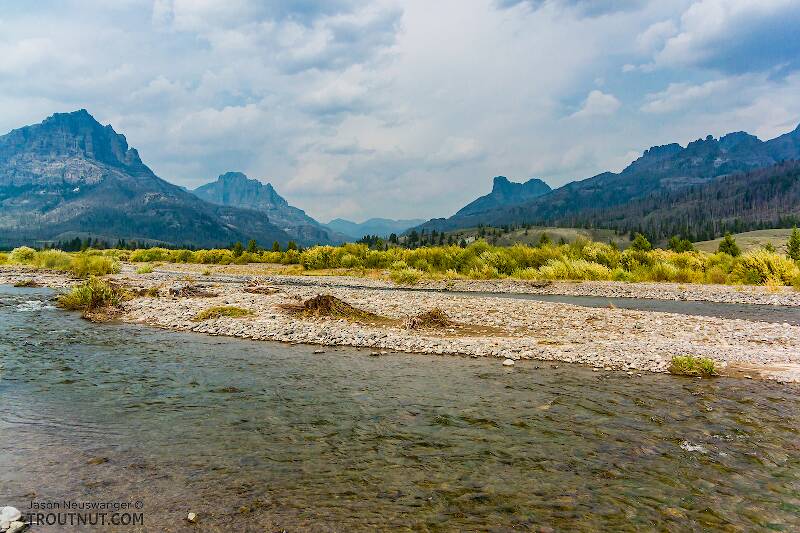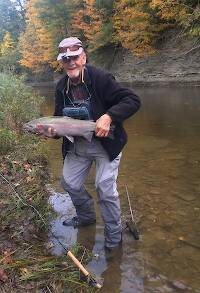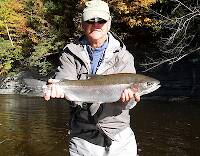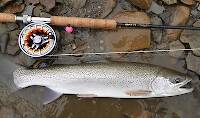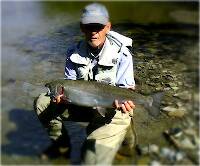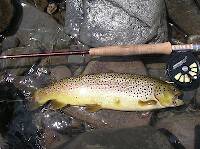
Hex Mayflies
Hexagenia limbata
The famous nocturnal Hex hatch of the Midwest (and a few other lucky locations) stirs to the surface mythically large brown trout that only touch streamers for the rest of the year.
Featured on the forum

Troutnut is a project started in 2003 by salmonid ecologist Jason "Troutnut" Neuswanger to help anglers and
fly tyers unabashedly embrace the entomological side of the sport. Learn more about Troutnut or
support the project for an enhanced experience here.
Wiflyfisher on Apr 14, 2012April 14th, 2012, 12:41 pm EDT
It's hard to rule out many heptageniids with what's visible in the photo. This is an early instar that's recently molted. Since one would think that March Browns would be a little further along at this time, I agree with John that one of the plethora of Cahills is most likely.
Nice photo, John.
When I picked up the rock and saw this whitish nymph, I thought the guys on TroutNut will like this as much as I do. :-) (And CJ on the SGM forum too.)
John S.
https://WiFlyFisher.com
https://WiFlyFisher.com
Seatrout on Apr 16, 2012April 16th, 2012, 4:08 am EDT
Looks good to me. It´s best to have some various colors in the arsenal and try most of them. That´s one of the joys of fly fishing, discovering new flies and patterns that work.
Martinlf on May 2, 2013May 2nd, 2013, 3:48 pm EDT
Here's the thread with the molted stone fly pattern by Paul (page 1), along with considerable discussion about fishing such flies.
"He spread them a yard and a half. 'And every one that got away is this big.'"
--Fred Chappell
--Fred Chappell
Entoman on May 4, 2013May 4th, 2013, 1:39 pm EDT
Thanks Louis! Mack's timeline in the other thread confirms what was suggested here. It seems that they stay light for 3 to 4 hours with another 3 to 4 hours growing progressively darker. Perhaps those that believe that they synchronize their final molts to some degree in the early morning hours of Spring (fishing pale flies dawn to mid-morning) are on to something?
Regardless, it seems to me that even if true (synchronous dawn molting) this would mostly be important only out West where their population densities are high enough to compensate for the tiny fraction of the molting population that would ever be in the drift. Even though I fish these kinds of waters, I'm not convinced of the need to lug specialized patterns around for this - especially If I'm not going to be on the water at the crack of dawn (which is most of the time). Do enough of that lugging already! :)
Regardless, it seems to me that even if true (synchronous dawn molting) this would mostly be important only out West where their population densities are high enough to compensate for the tiny fraction of the molting population that would ever be in the drift. Even though I fish these kinds of waters, I'm not convinced of the need to lug specialized patterns around for this - especially If I'm not going to be on the water at the crack of dawn (which is most of the time). Do enough of that lugging already! :)
"It's not that I find fishing so important, it's just that I find all other endeavors of Man equally unimportant... And not nearly as much fun!" Robert Traver, Anatomy of a Fisherman
PaulRoberts on May 5, 2013May 5th, 2013, 6:19 am EDT
I would agree. (But I'm still fishing my pale stonefly! For reasons already discussed.)
Entoman on May 5, 2013May 5th, 2013, 9:00 am EDT
Paul,
Yes, I think the bottom line is that while there probably aren't enough molts in the drift most times and places to get the fish dialed into them, your pale nymph scores on two points:
1. It is much more visible in the right light and water conditions.
2. Off-white nymphs do occur in nature and the fish surely recognize them as good vittles.
Reasons enough for their use.:)
BTW - Ever try a Bird's Stonefly type nymph? One in 2X long size 8 is a really good summer searching pattern in waters inhabited by both Perlids and Pteronarcyids. The medium brown coloration and smaller size does a good job simulating earlier instars of both, particularly the recently molted latter.
Yes, I think the bottom line is that while there probably aren't enough molts in the drift most times and places to get the fish dialed into them, your pale nymph scores on two points:
1. It is much more visible in the right light and water conditions.
2. Off-white nymphs do occur in nature and the fish surely recognize them as good vittles.
Reasons enough for their use.:)
BTW - Ever try a Bird's Stonefly type nymph? One in 2X long size 8 is a really good summer searching pattern in waters inhabited by both Perlids and Pteronarcyids. The medium brown coloration and smaller size does a good job simulating earlier instars of both, particularly the recently molted latter.
"It's not that I find fishing so important, it's just that I find all other endeavors of Man equally unimportant... And not nearly as much fun!" Robert Traver, Anatomy of a Fisherman
PaulRoberts on May 6, 2013May 6th, 2013, 9:01 am EDT
No I haven't tried Bird's Stone. I guess I like to invent my own. A large part of the fun for me. I tie my nylon stones in a variety of color patterns.
Entoman on May 6, 2013May 6th, 2013, 2:09 pm EDT
No, I meant the type based on color combinations and overall look, not the actual fly. Most western anglers focus on black or golden colored nymphs for stoneflies. His brown one broke from that norm. I only used it as a reference instead of a full description, knowing that you would recognize it. Sorry for the confusion.:)
"It's not that I find fishing so important, it's just that I find all other endeavors of Man equally unimportant... And not nearly as much fun!" Robert Traver, Anatomy of a Fisherman
PaulRoberts on May 6, 2013May 6th, 2013, 7:42 pm EDT
I see. I do have some stones in med brown hues of various sizes. All have pale bellies and vary in dorsal shade depending on where I'm fishing. My "golden's" vary from recently molted to a dark gold.
Pteronarcys has never taken much space in my boxes bc they are present in such low numbers in the East, and in the smaller water I currently fish here in Colorado.
Pteronarcys has never taken much space in my boxes bc they are present in such low numbers in the East, and in the smaller water I currently fish here in Colorado.
Entoman on May 6, 2013May 6th, 2013, 9:40 pm EDT
Yeah, makes sense. In a recent thread I think Dubbin mentioned the relative unimportance of the salmonfly in CO rivers. I found that quite surprising, but I haven't fished there much.
"It's not that I find fishing so important, it's just that I find all other endeavors of Man equally unimportant... And not nearly as much fun!" Robert Traver, Anatomy of a Fisherman
PaulRoberts on May 7, 2013May 7th, 2013, 7:35 am EDT
My guess is they are a big river critter -they are detritivores after all. I believe there is some salmonfly action on some of the larger rivers here, but is more miss than hit.
Martinlf on Jul 16, 2015July 16th, 2015, 9:39 am EDT
Here it is, Tom. Thought you might find this interesting.
"He spread them a yard and a half. 'And every one that got away is this big.'"
--Fred Chappell
--Fred Chappell
Quick Reply
Related Discussions
Topic
Replies
Last Reply
1
Sep 21, 2008
by GONZO
by GONZO

